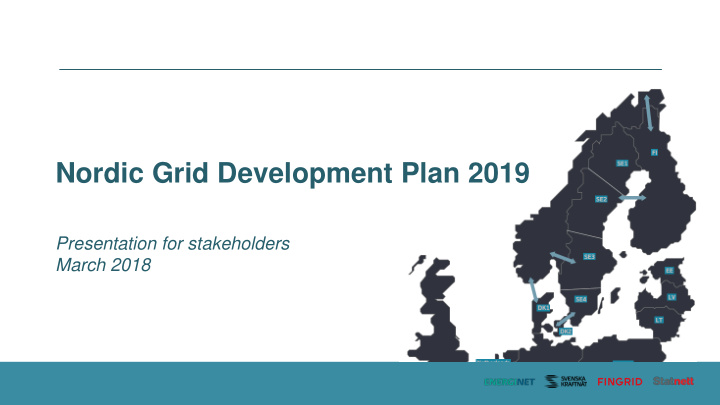



Nordic Grid Development Plan 2019 Presentation for stakeholders March 2018
Agenda • Background • Purpose • Scope • Relation to European, regional and national plans • Overall timeline • Nordic reference scenario • Harmonized CBA methodology • Bilateral studies • Stakeholder interaction Photo: Thomas Ärlemo
Background - Purpose • Communicate status of ongoing, planned, and potential Nordic investments, and how they contribute to Nordic socioeconomic welfare • Communicate a common Nordic view on the development of the future system, and how grid investments may help meet system challenges • Communicate results of new system analysis investigating the cost/benefit of further increasing the transmission capacity in the Nordic system • Function as a “bridge” between the ENTSO -E process and the national planning processes in the Nordics
Background - Scope • Establish a common Nordic Reference Scenario based on ENTSO-E/TYNDP scenario “Sustainable transition” • Harmonize CBA methodology for the evaluation of socioeconomic welfare • Carry out non-binding bilateral studies of the five corridors for an early assessment of potential benefits from a Nordic system perspective • Involve and interact with stakeholders to ensure quality
Background - Relation to European, regional and national plans National plans The way forward Nordic Grid Nordic – Solutions for a … complementary Nordic Development changing Nordic publications … Plan 2019 power system Scenario TYNDP 2018 Regional Plans, Pan European Scenario TYNDP2020 +++ ENTSO-E TYNDP 2016 Mid-term Adequacy Forecast System Needs, TYNDP 2018 MAF 2019 2016 2017 2018 2019
Background - Overall timeline 2017 2019 Sep Oct 2018 June Dec 2019 Jun Nordic Reference scenario Oct 17 – June 18 Harmonized CBA methodology Jan 18 – June 18 Bilateral studies Feb 18 – Dec 18 Jan 19 – Jun 19 Final report, communication
NGDP 2019 Nordic Reference Scenario
Drivers and major changes in the Nordics – Recap from NGD 2017 A. Integration with the continent/UK B. Integration of renewables leading to increased north-south flows C. New consumption D. Baltic integration E. Decrease of nuclear and thermal capacity Drivers are similar and becoming stronger when we look towards 2040.
Fundamental assumptions and storyline • Based on ENTSO- e scenario “Sustainable Transition” for continental Europe • Both coal and gas is competitive in the merit order, coal is forced out due to national regulation ie EU ETS CO 2 price is still not the only driver for de-carbonization • Rapid deployment of new renewable production. • Demand is growing only due to new demand types • A mix of energy only and capacity market • New sources of flexibility enters the market as thermal and nuclear is phased out Photo: Magnus Mikaelsson
Fuel prices and merit order
Demand • Demand driven by new consumption types eg EVs, Heat Pumps , new industrial applications Continent
Energy Balance • Renewables replace nuclear and thermal
Power balance • Conventional generation is phased out and replaced by new flexibility • Capacity margins will be much tighter
New flexibility • Additional flexibility in some EVs as well • Large scale storage could be hydrogen production • Load shifting could be industry changing fuels
Price volatility • More volatile price but the pattern is changing
Annual prices and energy mix in 2030 & 2040 • Nordics closely tied to the continent after new interconnectors
Continental prices • Convergence with UK and divergence with Poland
Economics of power plants • Low return for thermal plants from spot market • Achieved price drops for renewable generation
Sweden & Finland • Future of nuclear is a key uncertainty
Norway & Denmark • Y • Z
Baltics • Continued deficit situation both in terms of energy and capacity
NGDP 2019 Harmonized CBA methodology
Purpose and scope • To agree on a common Cost Benefit Analysis methodology for evaluating new potential grid investments of Nordic significance based on previous work in both ENTSOE and the Nordic region. • The aim is not to include all potential costs and benefits, but rather those that are deemed most important and possible to calculate/assess in the very early stages of investigating potential grid investments. Photo: Thomas Ärlemo
Work done so far • All benefits are calculated for the Nordic countries • Pan-European benefits reported for discussion Harmonized Non-harmonized • • Net Present Value – method Investment costs • • 4 % real discount rate Each TSO reports their best estimate of • 40 years of analysis period capital expenditure & operating expenses (25 years in sensitivity analysis) in their network area. • Currency: Euro • CO2 is calculated for the whole modeled area
Included indicators • Socioeconomic welfare • Grid losses • Impact on CO2 emissions Monetized • Costs • Security of Supply Generally not monetized, may be done if it is a key • Integration of renewable electricity economic driver for the investment • Environmental impacts Always assessed – degree depends on the investment • Flexibility, Balancing resource trade, Assessed when relevant to the specific investment, Reserves non-harmonized methods • Resilience, Robustness
NGDP 2019 Bilateral studies
Bilateral studies Corridor Focus/Drivers NO2-DK1 Aging of infrastructure of Skagerrak 1-2 NO1-SE3 Impact of the Swedish nuclear decommissioning SE3-DK1, SE4-DK2 Aging of infrastructure of Kontiskan 2 Investigate consequences of large wind expansion and industry in NO4-FI the far North Confirm results from 2016 studies and prepare for decision to SE2-FI (Kvarken) move forward with planning
Stakeholder interaction
Stakeholder interaction • Q1 2018: • Communicate the purpose and scope of NGDP2019 • Collect input from market actors on scenario and sensitivities, important aspects to investigate etc. • Q4 2018: • Present status on the bilateral studies • Collect input to the bilateral studies
Recommend
More recommend